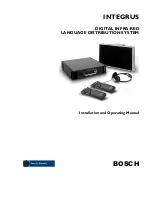
INTEGRUS | Digital Infra-red Language Distribution System
en |
11
BOSCH Security Systems | February 2003
100%
40%
100%
80%
Figure 1.10 The texture of the material determines how much light is reflected and how much is absorbed
Problems caused by shadows from walls or furniture can be solved by ensuring that there are sufficient radiators and that they
are well positioned, so that a strong enough infra-red field is produced over the whole conference area. Care should be taken
not to direct radiators towards uncovered windows, as most of this radiation will subsequently be lost.
1.3.5 Positioning the radiators
Since infra-red radiation can reach a receiver directly and/or via diffused reflections, it is important to take this into account
when considering the positioning of the radiators. Though it is best if receivers pick up direct path infra-red radiation,
reflections improve the signal reception and should therefore not be minimised. Radiators should be positioned high enough
not to be blocked by people in the hall (see Figure 1.11 and Figure 1.12).
Figure 1.11 Infra-red signal blocked by a person in front of the
participant
Figure 1.12 Infra-red signal not blocked by a person in front of
the participant
The figures below illustrate how infra-red radiation can be directed to conference participants. In Figure 1.14, the participant is
situated clear from obstacles and walls, so a combination of direct and diffused radiation can be received. Figure 1.13shows the
signal being reflected from a number of surfaces to the participant.


























